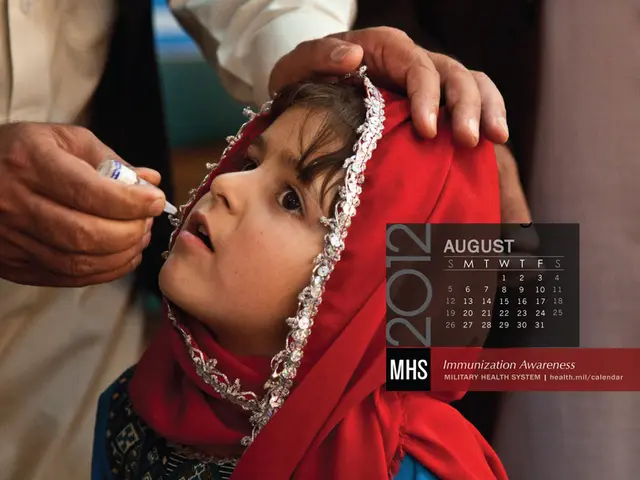Connection Between Breast and Ovarian Cancer: Identified Links and Potential Risks
Rewrite:
Breast cancer and ovarian cancer share a significant connection, mainly owing to genetic factors - especially for those carrying mutations in the BRCA1 and BRCA2 genes. This genetic link increases the likelihood of developing both cancers.
People with shared genetic risk factors might also have an increased risk of both cancers. Factors like advanced age, weight problems, and certain reproductive history can influence the risk, with some aspects potentially being modified.
The Dance of Genes and Cancer
There's a tangled web of links between breast cancer and ovarian cancer, with inherited mutations playing a starring role. The BRCA1 and BRCA2 genes, when mutated, significantly increase the risk of developing both cancers[1]. Approximately 1 in 4 families with a history of ovarian and breast cancer have BRCA1 gene mutations, and around 1 in 5 have BRCA2 mutations[2].
Are Genes the Only Players?
A family history of either cancer, older age, weight issues, reproductive imbalances, and certain lifestyle choices can also raise the risks.
- Family Ties: Having a family member diagnosed with either cancer increases the odds. The stronger the family history – especially in first-degree relatives – the higher the risk[3].
- The Aging Game: Both cancers become more common as we age. Ovarian cancer risks creep up after age 40, while breast cancer's risk tickles 55 years and beyond[3].
- Weight Matters: Being overweight significantly increases the risks for both cancers[3][4].
- Reproductive Riddles: Delayed childbirth, never carrying a pregnancy to full term, and never breastfeeding increase the risk for both cancers. Conversely, breastfeeding and oral contraceptives (for ovarian cancer) can offer some protection[3][4].
- Hormonal Havoc: Certain types of hormone replacement therapy, particularly estrogen-only HRT, up the risks for both cancers[3][4].
- Lifestyle Picks: Excessive alcohol consumption and sedentary lifestyle choices contribute to breast cancer risk and potentially influence ovarian cancer risk, too[4].
Family or environmental factors, such as shared lifestyle habits or environmental exposures, can also boost the risks of both diseases, irrespective of inherited gene mutations[6].
Can We Shake Off These Risks?
Some risk factors, such as previous cancer history, remain unchangeable. However, diligent monitoring, lifestyle changes, and sometimes preventive medical procedures can manage these unchangeable risk factors.
A history of breast or ovarian cancer increases the risk of the other, particularly if these cancers are linked to BRCA mutations. But people cannot alter this risk factor themselves.
Medical professionals may suggest regular check-ups (such as mammograms, MRI scans, pelvic exams, transvaginal ultrasounds, and CA-125 blood tests), genetic testing, and prophylactic surgeries for those carrying genetic mutations.
Modifiable Risk Factors
Modifiable risks encompass:
- Weight Watch: Maintaining a moderate weight level can cut down on breast and ovarian cancer risks. Being overweight may cause higher estrogen levels, which, in turn, can boost the risk of breast cancer[3].
- Physical Activity: Regular exercise reduces the risk of breast cancer, with a hint of positive effects on ovarian cancer risk as well[4].
- Alcohol Moderation: Cutting back on alcohol intake lowers the risk of breast cancer, especially if the consumption is high[4].
- Oral Contraceptives: Oral contraceptives offer some protection against ovarian cancer but may slightly raise the risk of breast cancer. Consult a healthcare practitioner for personalized contraception options[3][4].
Prognosis and Precautions
A 2020 study suggests that those battling both primary breast and ovarian cancer enjoy relatively favorable outcomes, with 5- and 10-year overall survival rates around 90%[7]. The outlook improves if the interval between the two diagnoses is lengthier. However, ovarian cancer following breast cancer often results in later-stage diagnoses, which may impact survival[7].
Age at the first cancer diagnosis and the time gap between the two cancers are essential predictors of overall survival. To learn more about individual outlooks, consult a healthcare professional.
Key Takeaways
The link between breast and ovarian cancer is tight – largely due to common genetic mutations, especially in BRCA1 and BRCA2 genes. People with these mutations face a significantly higher risk of developing both cancers.
Genetic testing, regular screenings, and preventive measures can be crucial for those at higher risk. Those who have had breast or ovarian cancer should stay alert for symptoms of recurrence or a second cancer. Early detection and swift treatment improve the odds of a positive outcome.
If curious about additional evidence-based information and resources for cancer, visit our dedicated hub.
Footnotes:
[1] National Cancer Institute. (2022). Genetics of Breast and Ovarian Cancers. Retrieved January 16, 2023, from https://www.cancer.gov/about-cancer/causes-prevention/genetics/brca[2] American Cancer Society. (2022). Ovarian Cancer Facts. Retrieved January 16, 2023, from https://www.cancer.org/cancer/ovarian-cancer/about/key-statistics.html[3] National Cancer Institute. (2021). Risk Factors for Breast Cancer. Retrieved January 16, 2023, from https://www.cancer.gov/types/breast/hp/breast-risk-fact-sheet#q2[4] World Cancer Research Fund International. (2022). Breast Cancer: Cutting Down the Risks. Retrieved January 16, 2023, from https://www.wcrf.org/dietandcancer/cancer-types/breast-cancer/cutting-down-the-risks[5] American Cancer Society. (2022). What Increases the Risk of Ovarian Cancer. Retrieved January 16, 2023, from https://www.cancer.org/cancer/ovarian-cancer/causes-risks-prevention/risk-factors.html#q1[6] National Cancer Institute. (2015). Environmental Factors that Influence Cancer Risk. Retrieved January 16, 2023, from https://www.cancer.gov/about-cancer/causes-prevention/risk/environment/genes-prenatal-exposures-fact-sheet[7] Iqbal, S., Khan, A. M., Khalique, S., Khan, M. U., & Khan, U. A. (2020). Survival outcomes in patients with both primary breast and primary ovarian cancer: A systematic review and meta-analysis. European Journal of Surgical Oncology, 46(3), 303-310. https://doi.org/10.1016/j.ejso.2019.07.023
- Inherited mutations in the BRCA1 and BRCA2 genes significantly increase the risk of developing both breast cancer and ovarian cancer.
- Approximately 1 in 4 families with a history of ovarian and breast cancer have BRCA1 gene mutations, and around 1 in 5 have BRCA2 mutations.
- Having a family member diagnosed with either cancer increases the odds of developing it.
- Both cancers become more common as we age, with ovarian cancer risks creeping up after age 40, while breast cancer's risk ticks up after 55 years.
- Being overweight significantly increases the risks for both breast and ovarian cancer.
- Delayed childbirth, never carrying a pregnancy to full term, and never breastfeeding increase the risk for both breast and ovarian cancer.
- Certain types of hormone replacement therapy, particularly estrogen-only HRT, up the risks for both breast and ovarian cancer.
- Excessive alcohol consumption and sedentary lifestyle choices contribute to breast cancer risk and potentially influence ovarian cancer risk, too.
- Regular exercise reduces the risk of breast cancer, with a hint of positive effects on ovarian cancer risk as well.
- Cutting back on alcohol intake lowers the risk of breast cancer.
- Oral contraceptives offer some protection against ovarian cancer but may slightly raise the risk of breast cancer; consult a healthcare practitioner for personalized contraception options.








